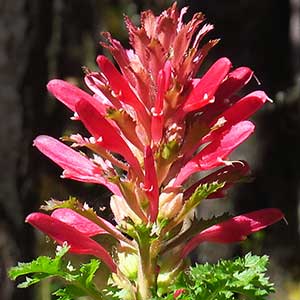Pedicularis densiflora
Pedicularis langsdorffii
Indian warrior, warrior's plume
Langsdorf's lousewort, Langsdorff's lousewort
basal 1–10, blade lanceolate, 30–200 x 20–70 mm, 2(or 3)-pinnatifid, margins of adjacent lobes nonoverlapping or extensively overlapping distally, 1-serrate, surfaces glabrous, hispid, or downy;
cauline 4–20, blade lanceolate, 15–250 x 5–100 mm, 2-pinnatifid, margins of adjacent lobes nonoverlapping or extensively overlapping distally, serrate, surfaces glabrous, hispid, or downy.
basal 0–10, blade elliptic, 10–30 x 3–15 mm, 2-pinnatifid, margins of adjacent lobes nonoverlapping or slightly overlapping distally, serrate, surfaces glabrous;
cauline 1–4, blade elliptic, 10–40 x 2–10 mm, 1- or 2-pinnatifid, margins of adjacent lobes nonoverlapping or slightly overlapping distally, serrate, sometimes crenate, surfaces glabrous, sometimes sparsely tomentose.
simple, 1–5, exceeding basal leaves, each 10–50-flowered;
bracts lanceolate to trullate, 10–35 x 3–5 mm, undivided or 1-pinnatifid, proximal margins entire, distal 1- or 2-serrate, surfaces glabrous.
simple, 1–6, exceeding basal leaves, each 10–50-flowered;
bracts subulate or linear, 5–25 x 1–10 mm, undivided or 1-pinnatifid, proximal margins entire, distal serrate, surfaces glabrous or sparsely tomentose to tomentose.
2–4 mm.
2.5–5 mm.
calyx 9–18 mm, downy to tomentose, lobes 5, triangular, 3–4 mm, apex entire, ciliate;
corolla 23–43 mm, tube dark red, purple, or orange-yellow, rarely white, 8–18 mm;
galea dark red, purple, or orange-yellow, rarely white, 15–25 mm, beakless, margins entire medially and distally, apex straight;
abaxial lip dark red, purple, or orange-yellow, rarely white, 8–15 mm.
calyx 6–11 mm, glabrous or +/- tomentose, lobes 5, triangular, 2–5 mm, apex entire or serrate to dentate, glabrous;
corolla 17–25 mm, tube pink or lavender, 11–13 mm;
galea pink or lavender, 6–12 mm, beakless, margins entire medially, 1-toothed distally, apex strongly arching over abaxial lip;
abaxial lip pink or lavender, 5–8 mm.
= 16.
Pedicularis densiflora
Pedicularis langsdorffii
Scarlet corollas with an undomed, toothless galea and two- or three-pinnatifid leaves are diagnostic of Pedicularis densiflora. This species occurs in forested subalpine regions of southern Oregon, western slopes of the Sierra Nevada, and the Coast Ranges of California south to Baja California. Herbarium records indicate northern populations of P. densiflora occur at higher elevations than do more southern populations.
(Discussion copyrighted by Flora of North America; reprinted with permission.)
Subspecies 2 (2 in the flora).
Pedicularis langsdorffii may be mistaken for P. hirsuta, P. lanata, and P. sudetica, which have similar growth forms and habitat requirements. Pedicularis langsdorffii generally has larger, pink to lavender corollas with toothed galeas that strongly arch over the abaxial lips in contrast to the smaller, toothless, pink corollas and slightly arching galeas of P. lanata. Pedicularis sudetica has up to five cauline leaves or lacks them. The straight, smaller galeas and pale pink or white corollas of P. hirsuta differentiate it from P. langsdorffii.
(Discussion copyrighted by Flora of North America; reprinted with permission.)
1. Bracts and calyces glabrous. | subsp. langsdorffii |
1. Bracts and calyces +/- tomentose. | subsp. arctica |


